
CHART
BOX
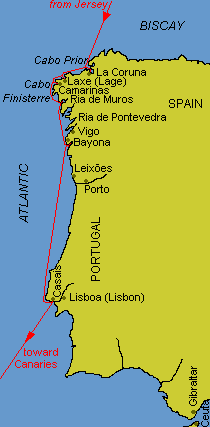
© Copyright 1999 Nigel Jones/MistWeb Software

Since I was a child I have known that many of our garden birds 'fly south' for the winter. I had thought little more about it other than, 'What a long way!' and 'Lucky devils!' This September we spread a pair of huge, white wings outside Bayona harbour and lined our nose up with two other Northern European yachts in front whose wings were already firmly set. I felt not like I was following the birds, but that we were part of that ancient and wise migration. It is in our genetic memory almost as much as it is in theirs. What would nomadic, Mesolithic Europeans have given for our facility with navigation and with sea travel?
 |
CHART |
 |
|
| Sketch Maps and Chartlets (not to be used for navigation!) © Copyright 1999 Nigel Jones/MistWeb Software |
|
The previous night we had been eaten alive by mosquitoes in the boat, at anchor in the bay of Bayona, just outside the harbour. As soon as we got back on board with today's shopping we had decided to bring all the exposed food up into the cockpit and follow the instructions on our new can of 'Raid' insect repellent spray. Having sprayed all around inside the boat, we were sitting for our designated 15 minutes in the cockpit, with the fruit and vegetables, and with the hatch-boards firmly in place.
"Did you see that lightning in the mountains?" Nicky pointed across the bay into the south-east.
"Wow, yes! Lucky the wind is blowing exactly the opposite direction so we won't get that here on the coast," I replied.
Five minutes later we were surprised by a few spots of rain and hurriedly cut short our fumigation to get the hatchboards out and get all the shopping away. The wind was still north-west so we thought little of it and set about laying out cold meats, cheeses, bread, pickles, olives, tomatoes and what-have-you for our evening meal.
An hour later, at about 9 p.m., around dusk and as we were enjoying maybe a second glass of wine, we became aware that the wind had picked up. I switched on the navigation instruments, which include a windspeed indicator, and stuck my head out of the hatch. The wind had swung us round 180 degrees, it was now blowing straight out of the mountains, and it had increased to about 12 knots - force 4.
Interesting, but no problem, I thought as I settled back down. A few seconds later we heard a gust and felt the boat sway under its force. The anemometer read 20 knots during the gust: force 5. I stood up to have another look around and was alarmed by a loud rumble of thunder. Within seconds another gust hit us and this time the anemometer read 30 knots (Force 7).
"Put all the tea-things away," I called to Nicky as I grabbed the handle for our manual anchor windlass. "I'm going to let more chain out."
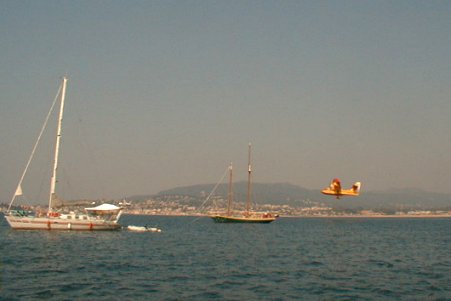 |
| In our last few days in Bayona there was another bush-fire in the mountains. This Spanish Fire Service sea-plane came back a dozen times to scoop thousands of gallons of seawater from the anchorage at Bayona. To skim the water so close to the yachts, at high speed, without stopping was a real feat of pilot skill. |
By the time I got to the fore-deck I was being lashed with hailstones that hurt and stung my skin. We were anchored in about 8 meters of water with 35 meters of chain out. The chain left our bow-roller so tight that I had to be really careful to keep control with the brake on the windlass as I veered chain until the 60-meter mark had passed by and disappeared below the water. Lightning was exploding in the hills and thunder was bowling across the water at us.
When I got back to the cockpit and put a Musto 'Ocean' jacket over my T-shirt and shorts, Nicky had stuffed all our foodstuff into lockers before anything was smashed or spilt and the wind was regularly gusting to 40 knots (Force 8). When it did so Rusalka's bow would often shy away from the blast and she would take it at an angle of about 45 degrees. At this angle, the wind was powerful enough to heel her over to 20 degrees and hold her down for maybe 20 seconds before easing enough to let her up and to get her bow back into the wind.
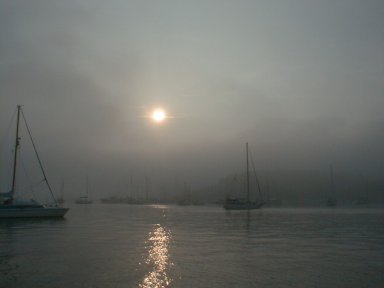 |
| Another beautiful, misty sunset seen through the yachts at anchor in Bayona, a few days after the storm. |
I know from watching other yachts do it that when a boat drags her anchor it is invariably in this angled crouch, and that the crouch that rips the anchor from the sea-bed is the one from which you never recover: dragging yachts stay bows-to-one-side and slide destructively back through the anchorage until something stops them. These 20-second strangle-holds the wind was putting on us had me holding my breath and willing the big CQR anchor to grip deeply into the mud.
Around us, other boats were already proving that this grip is not a foregone conclusion in these conditions. A British trimaran was the first to go and he slid back into the marina where, we later heard, he lost both his rudders in the collisions he suffered. He was followed by a heavy, Finnish, steel boat which also ended up in the marina: bouncing along the sterns of the yachts berthed bows-to, doing all kinds of damage to their windvanes and their steering gear.
Our friend Robert, a single-hander in a 26-foot boat dragged past us and all I could do was wave helplessly. In the same gust that had pulled his anchor free our rubber-dinghy, tied behind us by a single painter, had taken off and flipped over. One of the oars floated away and the outboard engine was totally submerged. There was nothing I could do about it now. We started our engine and I motored into the wind, using the rudder to try to straighten her up each time the wind laid her over, trying to help the anchor hold us fast. The wind was gusting up to 42 knots and that is the first time I have seen Force 9 on our anemometer display.
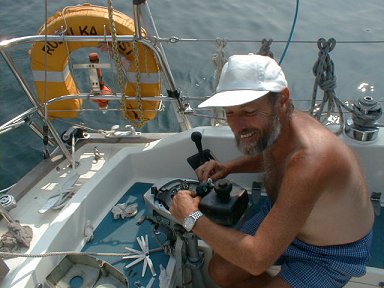 |
| Cleaning and setting the points in our drowned outboard, once the flywheel was off and the plug-lead reattached! |
A Swedish yacht, which is home to a couple and their two delightful little daughters, had been left unattended for the evening. It dragged away towards the rough, stone breakwater and, when it got there and continued to bounce against the boulders and concrete we were sure it would be holed.
I had never seen lightning like we saw that night. A vertical stab of fork lightning would hit the ground from the middle of the dark sky in the east then a horizontal fork, about the same length would travel across the sky toward the south. From the new point where this ended a third spark would stab down into the sea, then another horizontal, then a vertical and so on, from the east, right through the south, fully into the west in about two seconds. The thunder was all around us and these 180-degree spark-shows repeated every half minute or so for a while.
Gusts of wind clearly showed as white phosphorescent bands rolling across the water towards us out of the bay half a mile in front. When they hit us we were smashed by breakers a meter high which sent spray over into the cockpit. I had the hood of my jacket up and was glad of the Velcro and fleece that the kind people at Musto had thoughtfully provided for me.
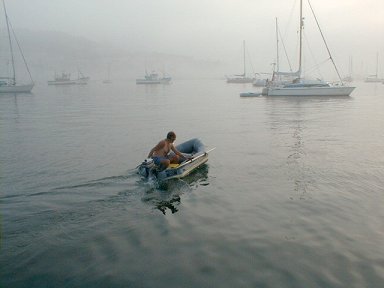 |
| Happily tuning the outboard having got it running again after its dunking. A few hours later and it all went pear-shaped again. |
It is difficult to say how long the worst of it lasted but it must have been at least an hour. Robert motored back up past us alternately tending his tiller then running forward to haul in some more anchor chain, then rushing back to try to keep control of the boat. He re-anchored nearby and it held for him. The Swedish parents appeared in their rubber dinghy heading for where their boat used to be. It must have been a horrible realisation that made them swing their tiller hard over to go to where she actually was - still bouncing on the inside of the breakwater. In the end, a crowded anchorage had been reduced to about six boats: us, Robert, a French family, an American couple and two large Dutch yachts had weathered the whole thing. The Americans and one of the Dutch had done so on nylon anchor rodes, which had been as tight a rubber-bands during the blow.
As we calmed down, switched off the engine and righted our drowned dinghy, we were surprised by the sight of Robert rowing towards us in his. When he got closer we called, "Do you want a coffee?" He replied by waving something high in the darkness and rowing on.
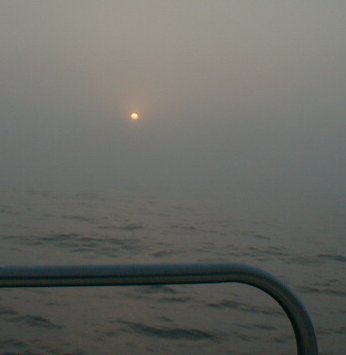 |
| Somewhere just behind this misty sunrise is the Portuguese coast. On passage to Cascais, near Lisbon I wanted to catch in a photograph that view of the sun that I have been trying for years to reproduce in the 'Rusalka Mist' logo - have a look at the top of this web-page. |
He arrived on board clutching an brand new bottle of Tobermory Single Malt Whiskey. He said, "As I was dragging back there I thought, 'Oh surely this is not how it's all going to end - on the breakwater in Bayona!'. So I got the engine going and sure enough - we made it!"
The Single Malt slipped down the three of us so easily in the calm, warm night that it was 3 am before he left. There was only an inch of the nectar left in his bottle as he disappeared into the night with it. We all slept very soundly.
The following day was calm, but by 1700 the next evening the wind was back up to 22 knots. The anchorage had just begun to fill up again. We had spent the day trying to get a spark out of our damp outboard. Everyone was getting worried about the wind. It died away again with no problem, it was just the weather saying, "I've done it before... and I can do it again whenever I want..."
We washed that outboard in fresh water as soon as we were up the next morning. We dried and oiled every part that we could get easy access to. One area this was not true of was the magneto and the points as they were hidden under a very protective flywheel. I tried to pull it off with 'reasonable force' but it would not budge and I did not want to damage anything, so we squirted WD40 through every gap, cleaned it all round with kitchen roll paper and hoped for the best.
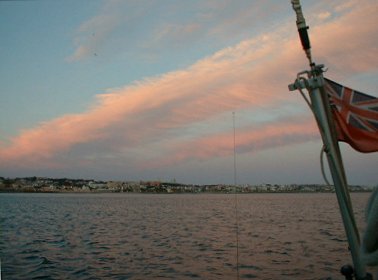 |
| In the evening sky this weak weather-front was so clear over the anchorage in Cascais, Portugal. The bottom edges of lows and frontal systems which dominate our lives further north can produce very gentle effects this much further south. |
Our hopes were not fulfilled. The engine would not start. There was no spark at all. When I measured voltages on the plug lead, where there should have been thousands of volts, there were three. Three volts were not going to make sparks.
Discussions of what might be going on left me with this image of a big blob of salty water across the points, stretching but not budging when they are meant to open, hidden under that flywheel. Robert suggested submerging the whole thing in petrol - I modified his idea to submerging it in alcohol. We carry a gallon can of meths on board whose main purpose is to light the Tilly lamps. Alcohol would dissolve the water, then evaporate quickly. We dismantled the engine again and did this. We put it back together and... nothing. Still no spark. Still only 3 Volts. When I was demonstrating this sorry voltage to Nicky, somehow in my kack-handedness I managed to twist the plug-lead in a new way and give myself and her a very healthy, multi-thousand-volt electric shock. Once. Once only, and I could not repeat it.
Beginning to feel that it's getting desperate I began to work harder on removing the flywheel. With two screw-drivers and a heavy mallet on the job it eventually came free. The points were healthy and dry. There was no serious corrosion, but... The plug lead had fallen off! With all the cleaning and fiddling around the plug lead had completely fallen off the connection it was supposed to make to the high-voltage coil. With this back on, there were healthy sparks and the only thing preventing the engine from starting was the carburettor-full of water. I unscrewed one of the mixture screws completely and let the water then some petrol dribble out and it started!
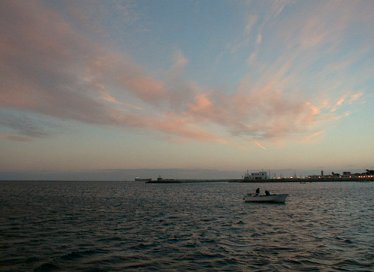 |
| Just like their bigger counterparts twenty or thirty miles off the coast, the small-boat fishermen in Cascais had two huge lamps rigged either side of their boat to attract the fish to them. These fellows were anchored next to us for the night. Others were dotted around the bay. Cascais Marina is in the background. |
It ran badly and inconsistently at first so I roared around the anchorage in the dinghy for an hour trying to tune the carburettor and waiting for all the water to work its way through. It was getting a lot better when I decided to call it a day. The next morning (day 3 now) I climbed back into the dinghy and started it up. I had only gone 20 yards when it stopped very abruptly. There was no rope in the propeller, but I could not turn it over at all.
Day four's investigations showed not only that one of the main crankshaft bearings was completely seized, but that it had only ever been mounted by two of its four mounting bolts for many years. The aluminium casting was cracked in two places and, judging by the dirt and corrosion in the breaks, had been so for a very long time. The extra stresses of the lack of lubrication caused by running on water instead of two-stroke mix coupled with the misalignment and vibration that these breaks must have caused broke the camel's back and the whole thing ended up in three rubbish sacks in the skips on the pier.
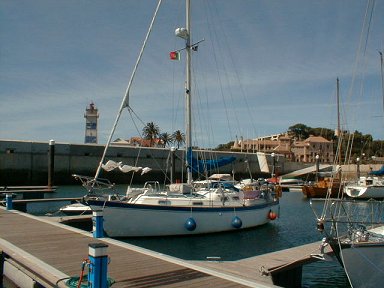 |
| It was a bit of a treat to back in a marina again. You can see that the authorities were stretching the point a little to say that they were full up and ask us to call back a week later to see if there was a space yet. This was taken the morning after we tied up. |
The next day, we rowed back to the little shop who had sold us a new pair of oars straight after the blow. I had seen one outboard engine on display there. Luis eventually parted with his Honda 4-stroke 2 hp for 90,000 pesetas (about £360), and it is truly wonderful. It is so quiet, so easy to start and so powerful compared with the other old banger. It is very little heavier than the old 2-stroke but is also more economical on fuel, produces no smoke and no smell when the wind's behind you. Luis was very fair and told us that they are less expensive in the UK. He was correct but only just - the Cruisermart catalogue price was £359 excluding delivery! Luis's shop in Bayona has its own web-site at www.arrakis.es/~estelas. He was very helpful and, the next day, sailed out to us in his sailing dinghy to show his wife/girlfriend our boat and to ask us if the engine was all ok. You don't get that from Cruisermart!
As soon as all this outboard engine business was settled we decided it was really time to fly south. The beginnings of autumn seemed to be settling on Galicia. We bid farewell to Robert and headed out into the bay on the 8th September 1999. We had planned to stop a few times in Portugal, at least at Leixões, near to Porto. Recent events made us decide to keep going and we shaped a coastal course right down to Cascais, outside of Lisbon. This was a 48-hour journey with the forecast of a good following wind - north-easterly forces 3 to 5 according both to Monsanto Radio on the Navtex and Bill, G4FRN, on the UK Amateur Radio Maritime Mobile net on 14.303 MHz HF (Short-wave).
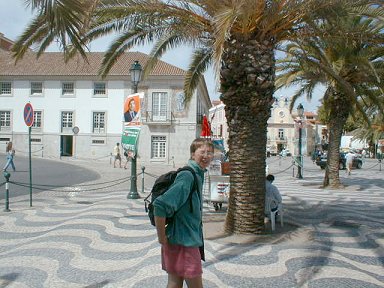 |
| On our first trip ashore in Portugal, Nicky and I walked into the main Praça or square on the waterfront in Cascais. Palm trees and cobbles are everywhere suddenly. |
The first afternoon passed without incident but by the time it was dark, the wind had piped up to the full force 5 prediction, reaching 22 knots actual - only 16 knots apparent across our decks as we ran away from it at a powerful 6 knots. The main-sail was held right out with a preventer, a safety rope from the end of the boom to our bow, through a snatch-block and back to a cleat on the cockpit coaming. Our mast-head tri-colour light has not worked since the banging and slatting of our Biscay crossing loosened its wiring (I eventually got up the mast and fixed that in Cascais).
After midnight I was watching the mast-head light of another yacht coming out from the Portuguese shore only 15 or 20 miles away and crossing behind our stern in the full beam of our white stern-light. Judging by his better speed he was a bigger yacht than us, and although his course was a bit erratic he was soon overtaking us a quarter of a mile away to starboard. Suddenly on the radio a thin, young voice came through on channel 16: "Sailie yacht, Sailie yacht, you hef no lights, you hef no lights"
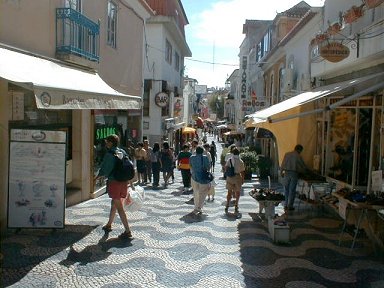 |
| Cobbles and bustling streets: Cascais has a good range of shops and a very commercial, consumerist atmosphere. |
As I looked to confirm a good glow from both bow and stern, suddenly the night was split open by an extremely bright searchlight straight in my eyes from his bow. The light flashed and wobbled, illuminating our sails like day and killing my night-vision. I reached for the radio mic and replied, " Yacht with the searchlight, this is Rusalka Mist, Rusalka Mist. We have lights, thank you. We do not need the searchlight on us."
"You hef no lights, you hef no lights," his voice was more like a taunt now. Then channel 16 came to life with loud, fast, heavy-metal music. After a while the light began searching the rest of the sky and the horizon, and we were treated to more sporadic bursts of the hyper-active heavy-metal guitars. Their yacht drew further ahead and further away out to sea. Suddenly there was a clear sound of gun-fire - perhaps a heavy-bore shot-gun - from their direction. I estimated that they were now well out of gun-shot range from us - at least a couple of miles - so I was not unduly worried.
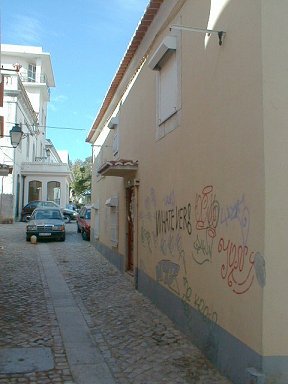 |
| The back-streets of Cascais are intricate and tiny. The local young people seem free to liven the whole place up with their graffiti - often in English and quite carefully executed. It is usually strange and often more obscene than this. |
We wondered what might have been going on aboard that boat. We imagine a crowd of kids - maybe young men of about 18, perhaps at the end of their celebratory summer holiday before University - somehow allowed to go for a night-sail in Daddy's rather splendid yacht. As the night goes on and the beer stocks go down they start rummaging in lockers to see what they can find, radio transmitter, searchlight, stereo system, shot-gun and cartridges. We hope their hangovers allowed them to get it all put away and the boat back up-wind and into their home-port at some reasonable hour of the next day!
Later in the night we were passing through a fleet of Portuguese fishing boats. This is always fraught as both fishing and sailing give you special rights of way at sea. The problem is that no-one seems sure whether fishing gives way to sail or vice versa. These boats were heavily illuminated with brilliant white lights pointing down into the water, presumably to attract the fish up into their nets. All was going well until one of the boats turned across our bows and rounded up alongside us only a few hundred meters away. No problem so far but when he began shooting nets over his stern (clearly visible to us in his lights) and cutting across our bows again, I began to wonder if he had seen us at all.
"How do we stop?" I wondered out loud as the increasing seriousness of the situation dawned upon me. The full mainsail and its preventer were our main source of power and they were not something I could easily remove in the time we had left before a likely collision. Luckily we were on starboard tack and so I could snap off the automatic steering and push the tiller hard down. You really must not turn to port as a collision-prevention measure. If both boats always turn to starboard, any collision can be prevented, but if one goes the other way many possible collisions will simply happen somewhere else.
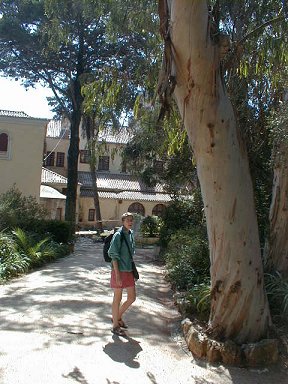
|
| Nicky and I went for some peace and quiet in the park on our side of Cascais. Here a magnificent eucalyptus tree winds its way into the air. |
With us beam-on to the wind, the mainsail began to flap, our speed dropped to about 2 knots of steerage-way under the two jibs and the fishing boat passed safely along our port side. I reached for the horn button and gave the sound-signal for a sailing vessel under way (dah-di-dit). There was suddenly a flurry of activity on deck and the second searchlight of the night was trained upon us. Over the glare of their 1000-Watt fishing lamps our little 10-Watt navigation lights had not been seen and they had been quite unaware of our existence until that moment. I made a mental note to get some much bigger and more serious bow and stern nav-lights fitted soon.
After this we were starting to wonder if we were invisible in some way so we switched on all the navigation lights we have that work and put our powerful searchlight ready near the companionway as I settled down to a very diligent night-watch.
During the next morning the wind died a little and by the next evening we were motoring beneath the stars. As we go further south, even to my eye, the night-sky is changing. The southern sky is full of constellations I do not know. Orion rises on his side in the east and travels high up towards the zenith at dawn. The Pole Star is noticeably lower in the sky and the 'handle' of the Big Dipper scrapes the horizon as it describes its circuit of Polaris.
The second night held a few moments of tension as we threaded the gap between Cabo Carvoeiro and its off-lying islands. The rear-most of two fishing boats coming the other way had clearly not seen us until we were quite close. As they went past I could see why. The working lamps of the front boat were so bright - and directed aft - that I imagine they completely dazzled the helmsman of the second boat to our nav-lights. Once again I thanked providence for our radar which allowed me to keep a 'bird's eye' view of the situation and react appropriately.
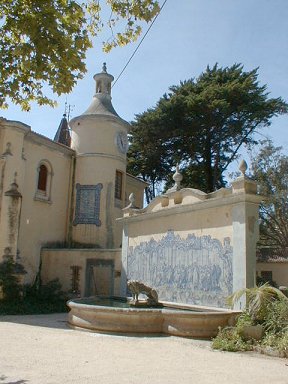 |
| Within the park at Cascais we came across this magnificent building and its tableau of ceramic tiles, all locked up and derelict. |
I found this long, coastal passage with its associated adventures unduly tiring. I future I would take the advice of Gote, the Swedish/Australian singlehander in Polo Flat, whom we had met in Bayona and would catch up with again in Cascais, and keep much further out where the excitement level is more reasonable. He made this passage himself a week before and saw very few other boats, ten miles further off the coast.
Cascais (pronounced 'Kesh-kaysh') is a small town up behind a tuck in the coastline just outside the entrance to the River Tejo, 15 miles before you get to Lisbon further up the river. The waterfront of Cascais runs north-south, facing east, even though the main run of the coast here is east-west. This little bit of shelter from the open Atlantic must have been what prompted the fishermen of old to found a town here. The most sheltered corner of sea is now, of course, filled with permanent moorings for local craft. When we arrived at midday on Friday 10th September we were surprised to see only one other cruising yacht anchored just outside the local boats.
We dropped our anchor just outside of him, in about 6 meters of water, and looked again at the aerial photo in the pilot book (The Royal Cruising Club's Atlantic Islands by Anne Hammick). We were in the right place, but the photo showed dozens more yachts in the area we were in. We recognised the yacht from further up the coast and when its French crew appeared, returning from the fisherman's pier by dinghy, we gestured them over. Like many French yachtsmen we have met they were reserved and not keen to chat. They told us we were in the right place, and that we must take an anchor with us to the pier and lay our own outhaul mooring every time we go ashore. They had a large rock with a string around it on the floor of their boat and the tangle of line to prove it. They coaxed their old outboard back to life, returned to their yacht and promptly upped their anchor and left. We certainly did not expect this degree of solitude here!
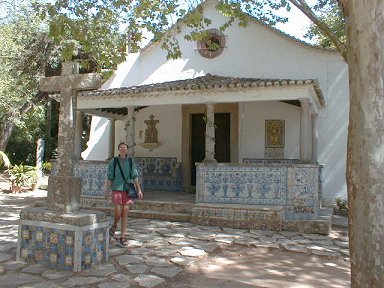 |
| Cascais's park also contained this church, apparently forgotten and left behind by the busy town. |
I slept the afternoon away while Nicky read, tidied the boat and watched life in the bay. The next morning we pumped up our dinghy and put our lovely new outboard in place. We had intended to be very diligent about Customs and checking-in procedures, but the marina officials had been so uninterested in our requests for Aduanas forms in La Coruña when we arrived in Spain, that we decided to skirt the issue here and just have a look around. Our pilot book told us to tie up at the Club Navale - the yacht club - and mentioned nothing about anchors and outhauls so we went that way and tied to a very rough, mussel-encrusted slipway next to the yacht club's launch.
The town is distinctively different to what we have got used to in Spain. The pavements are cobbled with loose little blocks of what looks like marble, often in white and black, making swirley patterns. Palm trees grow everywhere, lining the quay and streets. The racing yachts on their trailers all around the quay look expensive and seriously maintained. Their bottoms are polished to a higher gloss than our topsides or my car has ever seen. The street hawkers are more pushy than ever and they all speak perfect English immediately. The coffee shop menus are in English and Portuguese. All our worries about having to learn yet another language faded quickly.
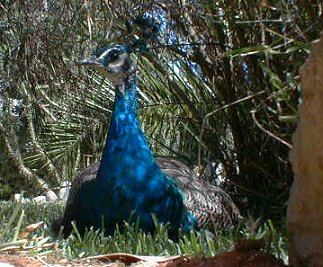 |
| This splendid peacock also lives in the park at Cascais. He didn't mind having his photograph taken at all. |
We found the huge hypermarket called Jumbo, mentioned in the pilot book. Here you can load your trolley with all the groceries, a new bike, four new tires for the car and still have room for a computer, fishing tackle, an aquarium and all your stationery requisites. We just had a beer and a Fanta in the bar and decided to go back on Monday with two rucksacks!
The marina was not shown at all on the British Admiralty chart even though it was corrected up to June 1999. It was shown as a set of dotted lines in the pilot book as of August 1995. Luis, the friendly chandler in Bayona, had said it was now open and here it was, large as life so we decided to have a look around. We were quickly challenged by a security guard and had to say we were looking for the office to enquire about prices in order to forestall him throwing us out bodily.
We were directed to a big house overlooking the whole complex where we were cordially shown into a beautifully furnished sitting room and asked to wait. After about twenty minutes a very smartly dressed woman came in and charmingly told us how sorry they were to tell us that they were completely full and could not help us. We asked about the rates anyway and she told us that, as they were not formally open yet, those yachts inside were there as their guests and were paying nothing for the time being.
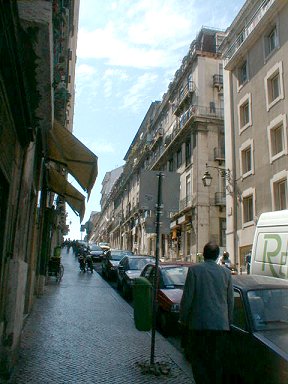 |
| We were not impressed with Lisbon. Maybe we just never found the right bit, but it all seemed noisy, dangerous and grubby. We had trouble finding any interesting shops to wonder around. |
We had not seen much of the place before Security had homed in on us, but my overall memory had been of miles and miles of brand new, empty pontoons. I mentioned this as charmingly as I could and she said that they were all either sold, leased or booked. In any case I had been looking at the local-boats' area, the visitors' area was further in. Perhaps if we called again next Thursday, she might have a space. We left it at that.
When the time came to return to the boat, we found the gates of the Club Navale firmly padlocked. We walked around and eventually found a back way in. The dinghy had been moved and the crew of the launch were unloading English-speaking passengers onto the slip, all in the way of another English speaker who was trying to roll his Hobie Cat trailer down to the water. When the rush had died down we asked the men in the launch if the dinghy had been in their way. Apparently they had lost all their ability with our language and all we got was an abrupt stab to the air over a shoulder with one thumb, as the launch roared off to get some more passengers from somewhere.
Back out in the bay the light southerly which had wafted us in was replaced with a robust northerly wind which we began to recognise as our first taste of the famous Portuguese Trades. The bay is well sheltered from the north but by Sunday morning the wind was gusting to 30 knots - force 7 - and we had the dinghy outboard back on board and our full 65 meters of anchor chain out. We did not want to leave the boat in this, even though the sky was a perfect blue and every Portuguese boat, windsurfer and jet-ski was out tearing up and down the bay. The Monsanto Radio forecast on the Navtex said Force 4 to 5 and no-one except us seemed at all fazed by this blow. Maybe this is what it's like to live with trade winds, we thought, but then began to get depressed as the whole of the rest of our trip will be in trade wind areas. By Monday morning there was no sign of these winds easing so Nicky tried a phone call on the mobile phone to the marina office. She got the same initial response, but worked up a whole story about how far we had come and how very tired we both were and how much we would like to see their town. I knew she was getting somewhere when she started telling the woman how very kind she was to even look at her booking sheet. "Yes," she was told, "you are very lucky, a space has just come free."
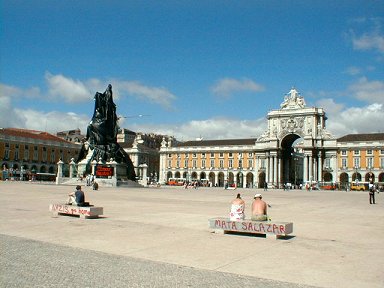 |
| During our stay, the story of atrocities in East Timor has been on the world's headlines. In Portugal, the imperial past connections have made it dominate. Here in Lisbon all the major statues that could be scaled have been draped in black as a mark of solidarity with the Timorese. |
We had the anchor up in minutes and were heading into the hallowed portal. As we rounded the corner into the visitors area, we were greeted with a cheery "G'day! Ya made it, then?" from Gote, standing in the cockpit of Polo Flat on the end of the first pontoon. As we came in we saw all the old reprobates in here. All the scruffy old touring yachts we had travelled with since La Coruña were lined up like street-people at some kind of posh tea-party on the rose-pink, teak pontoons.
We chose a berth from among the dozens of free spaces, said hello to a few more old faces then headed up to the big house on the hill clutching passports and all the official-looking papers we could find on board. After a ten-minute spell in the sitting room we were taken deeper in, where all our paperwork was photocopied and a few forms were filled in. No-one mentioned money and we are too well-bred ourselves to bring it up, so after less than an hour we were free to leave. The only problem was that the berth we had chosen was, of course, booked so we would have to move immediately. When we got back to the boat a team of three young men on the staff had been detailed to take our lines and help us move to our 'official' berth.
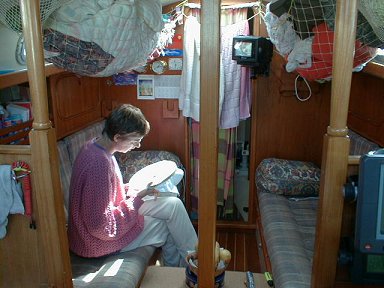 |
| Catching the slant of sunshine through the fore-hatch, Nicky works quietly at her cross-stitch. This is a new hobby, inspired by the little stitchery shops in Galicia. |
We have since learned that the problem all along was probably our dress. We were wearing the usual shorts and t-shirts with sandals that have done for us since July (they have been washed now and again!). Others have got straight in by turning up in the marina office looking rich, clanking a bit of gold jewellery, showing a Gucci logo here and there and with a pair of sunglasses on the top of your head. "Certainly, Sir and Madam, right this way..." If you want to look like you are thinking of buying the marina, not just renting a berth, you do all of the above then put on a brand-new jacket without putting your arms into the sleeves. The most upwardly mobile Portuguese sit clutching their lapels together in the trade winds having their shoes shined in the square in this way.
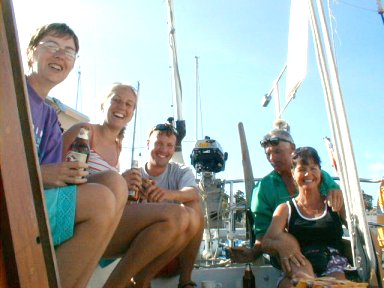 |
| From left to right, Nicky, Rebecca, Richard, the shiny new outboard, Bill and Ann. All having a beer (except Ann and the outboard!!) after Bill had winched me up the mast to fix our mast-head navigation light (corroded contacts on the bulb!). |
We took a train ride to Lisbon (only 400$00, 400 escudos, about £1.30, day-return) where we got jostled off the pavements, terrified by the traffic and choked by the fumes for a couple of hours before retreating into the safety of a chandlery next to the station. Here presentation of our card, with the web-site address on, got us excellent service and long conversations about the running of a chandlery shop and the pros and cons of opening a branch at Cascais Marina. I eventually got a pair of very serious looking Dutch navigation lights for our front and rear, complete with a good supply of 25-watt bulbs for them. These with a pair of wet-suit boots for Nicky added up to about £100.00 so I assumed we were getting gently done over into the bargain. When we got them back to the boat, I looked up the equivalent AquaSignal lights in the Cruisermart Discount Catalogue. The lights alone were £49.95 each without delivery so actually, once again, there is no problem with buying locally.
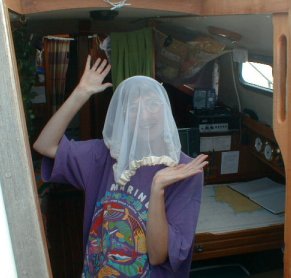 |
| Just before we left Cascais, Nicky finished an elasticated mosquito net which fits perfectly over the open forehatch, for those hot, buggy nights in port. Here she models it fetchingly in the companionway. She has plans for netting the companionway too, but that's a big job... |
It now seems to me that the Portuguese drive their fishing boats and their cars in a similar way, substituting the dazzling searchlight for the horn when afloat. The local English-language newspaper seemed quite proud to announce last week that once again Portugal has topped all polls for the number of road deaths, road accidents and injuries-per-mile in the whole of Europe. We will need all the help we can get to get out of these waters and these nav-lights will be just a part of the plan. Our horn and our searchlight will be ready for use and, now I know the locals a little better, I shall not be too English and reserved about using them early on, regardless of technical issues involving rights of way!
We've seen some more nasty weather here as a big low-pressure system hit Ireland and the UK with gale force winds on the 18th September. We only saw force 6 gusting to 7 but it was from the south-west which would have hit us badly out in the bay. The marina officials were very helpful and said they would be keeping an eye on everybody's ropes etc through the night. This was their first storm of the year and probably the first ever since the marina was populated and staffed.
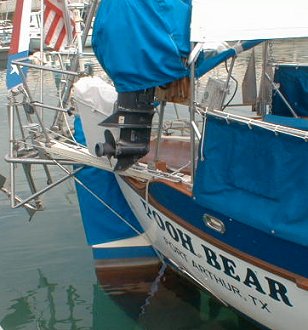 |
| Unfortunately we did not really have time to get to know Bob and Judy, from Texas, when they became our neighbours in Cascais - we were almost ready to go. Nicky was taken by the name of their boat. Her niece, Tasmin, she felt, would have immediately jumped ship to sail with Pooh Bear. Their dinghy was called Piglet. |
We have found our way around Cascais and now enjoy our trips ashore. We can buy today's English papers in the railway station kiosk, enjoy a coffee and either a croissant, a danish or a pastel nata (a wonderful custard tart), then hike off to Jumbo to buy more stocks for the boat to replace all the tins and bottles we have emptied in the last two months. We have eaten sardinhas and elaborate salads at pavement restaurants and even had an excellent Chinese meal for under 5000$00 (£16) for the two of us. The little lacquered plaster Buddha who accompanied our bill was a gift for us to keep. He now has a good home on top of the SSB radio, next to the GPS satellite navigation receiver. As I said - all the help we can get!
On Saturday 18th September I wrote,
It's been a quiet, in-doors, sort of day today - just like Winter days at home - except its a chilly (for us) 21°C. We watched a Walt Disney film (English with Portuguese subtitles) and now Nicky is working on her cross-stitch while the rain pours down the windows. It's quite windy - about Force 6 or 7 - but we're very safe in here. For tomorrow we have bought some lamb and are planning something a bit like a Sunday Dinner for during the rain. Yesterday afternoon we had a cockpit full of all our new friends from the other boats, drinking beer and having a good time, after I had had to be winched up our mast to fix the mast-head light. Not a bad life!!
 |
| As the storm-clouds cleared during our run to Tenerife we were treated to this rather stunning rainbow in the middle of nowhere. |
The sun has moved 20 degrees south since we left Jersey in July (Its declination has changed from about 20°N to 1°N as we approach the Autumn equinox). We have moved only about 10 degrees south (From 49°N to 38°N). Tenerife is at 28°N so we should be back to the sort of weather we expect in Jersey in July when we get there later in September. The boat is stocked up again and now that these nav-lights are wired in we are ready to be off as soon as we see those blue skies and North-East Trades again.
Click here to read the story of the next part of the flight south - the 700-mile trade wind blow to Tenerife in the Canaries